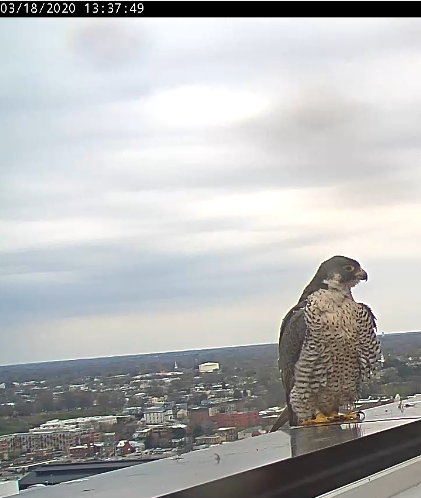For many people, the mention of a peregrine falcon immediately conjures up images of a raptor diving through the air at breathtaking speed to strike and kill its avian prey. Talk to a DWR biologist about peregrine falcons, and it will evoke vivid memories of fending off peregrine attacks while retrieving falcon chicks for banding from the outer walkway of a downtown Richmond hi-rise, 21 stories above the hard pavement below. Talk to yet another DWR biologist and it will summon images of peregrines peacefully soaring among the cliffs in Virginia’s mountains over a gorge on a warm spring day.

Peregrine falcon chicks banded.
The nesting season of this iconic species is upon us once more. It is at this time of year that peregrine falcons are busy courting, through ritualistic displays given in flight or at the nest site, or have already gotten down to the business of laying eggs. After roughly 5 weeks of incubation these eggs will hatch; the young will grow rapidly and then leave the nest, or “fledge”, approximately six weeks later, sometime during the month of June or July.
Like many other raptors, peregrine falcons were historically persecuted in the United States, but it was the widespread use of the pesticides such as DDT in the post-World War II era that had population-level effects, leading to the effective extirpation of the bird as a breeding species east of the Mississippi. Along with the banning of DDT, a well-coordinated reintroduction effort began across the East in the 1970s and rapidly yielded results; the breeding falcon population rebounded and was removed from the federal list of Threatened and Endangered species in 1999. In Virginia, reintroduced peregrines nest on bridges, buildings and other artificial structures in the Coastal Plain — in recent years this segment of the population has hovered between 20 and 25 pairs. The recovery has been much slower in the mountains of Virginia, where peregrines had once been documented to nest at over 20 sites. As of the year 2000, only one pair was known to be nesting on a natural cliff — this site was found within Shenandoah National Park, and peregrines continue to nest at the Park to this day.
In recent years, DWR has worked with partners such as the National Park Service, US Forest Service, The Nature Conservancy, West Virginia University and the Conservation Management Institute at Virginia Tech to ramp up our collective “ground game” in the Virginia mountains. The search is on for peregrine nest sites on natural cliff faces within the bird’s historic breeding range. Over 35 sites have been visited since 2010, with over 25 of these receiving more intensive surveys. Long drives, hikes along narrow mountain trails and hours spent behind spotting scopes have paid off: 3–4 natural cliff sites occupied by peregrines have been documented in recent years. Although this may not seem like a lot, it is indeed a big deal, marking a slow but undeniable expansion of the peregrine population into its former breeding range. These sites include Shenandoah National Park, as well as three previously unknown sites. One of the sites was occupied by peregrines as a direct result of reintroduction efforts known as hacking.

Adult female peregrine falcon in Richmond, VA.
A breeding pair established itself at Breaks Interstate Park in Dickenson County on the heels of hacking in 2007 and 2008 — the first time that peregrines nested at the Park in nearly 50 years. Peregrines recently began breeding at another site, White Rocks in Lee County (at the very southwestern tip of Virginia), without any hacking having taken place. Another site in Rockbridge County was occupied by falcons for two years, but has not been used recently. In addition, individual peregrine falcons have been reported in the vicinity of other Virginia mountain sites, and we feel that it is only a matter of time before new breeding pairs are “discovered.”
While efforts to document new peregrine sites in the mountain continue, we invite you to follow our Richmond Falcon Cam blog, where we chronicle the nesting season of a pair of urban peregrines in Virginia’s capital via our new live stream. Be sure to also visit our website for more information on peregrine falcons and on falcon recovery efforts in Virginia.

